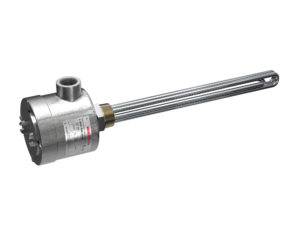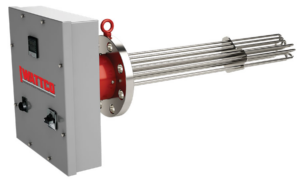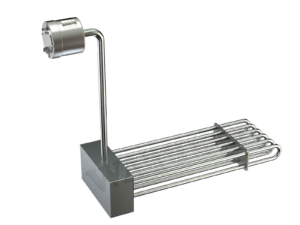Using Immersion Heaters in the Food Industry
Last updated on November 16th, 2023 at 08:43 pm
How to Select the Right Immersion Heater for Food Processing
Immersion heaters, as the name implies is a kind of heater that is immersed into the medium to be heated. Types of electric immersion heaters vary with their installation postures. They can be installed in a threaded, flanged or over-the-side position.
 Threaded Heaters-Threaded or screw plug heaters consist of tube-shaped heating elements welded in the heater. The heater either directly screws or plugs in the system through a threaded opening. A common use of these heaters is heating corrosive chemicals and fluids. The easy-to-handle and energy efficient heaters can well suit a wide range of industrial applications.
Threaded Heaters-Threaded or screw plug heaters consist of tube-shaped heating elements welded in the heater. The heater either directly screws or plugs in the system through a threaded opening. A common use of these heaters is heating corrosive chemicals and fluids. The easy-to-handle and energy efficient heaters can well suit a wide range of industrial applications. Flanged Heaters– Just like threaded heaters, flanged heating systems also consist of bent heating tubes, welded in the base of the heater. However, unlike threaded heaters, flanged immersion heaters have to be welded to the vessel or the system in which it has to be installed. These heaters are difficult to uninstall. As a result, they are usually used in industries like chemical manufacturing, food processing etc. where high pressure vessels are used.
Flanged Heaters– Just like threaded heaters, flanged heating systems also consist of bent heating tubes, welded in the base of the heater. However, unlike threaded heaters, flanged immersion heaters have to be welded to the vessel or the system in which it has to be installed. These heaters are difficult to uninstall. As a result, they are usually used in industries like chemical manufacturing, food processing etc. where high pressure vessels are used. Over-the-side Heaters– these heaters are designed for the tricky systems which don’t allow through the side heating (due to their construction). As the name implies, over-the-side heaters have their heating elements positioned along the side of the system in which they are installed. Some over-the-side heaters can also have their heating elements at the base of the tank or vessel. These heaters are easy to install along the side of the tank. Their most common use is in tankless heating systems. In which, the heated fluid is not stored in the vessel, but directly transported to where it is required.
Over-the-side Heaters– these heaters are designed for the tricky systems which don’t allow through the side heating (due to their construction). As the name implies, over-the-side heaters have their heating elements positioned along the side of the system in which they are installed. Some over-the-side heaters can also have their heating elements at the base of the tank or vessel. These heaters are easy to install along the side of the tank. Their most common use is in tankless heating systems. In which, the heated fluid is not stored in the vessel, but directly transported to where it is required.Uses in Food Industry
The food industry mainly uses immersion heaters for high pressure gaseous and fluid heating systems. From hot water storage tanks to preheating food processing equipments. Some of the common applications of immersion heaters in food industry are:
- Boiler equipments.
- Preventing liquid and gaseous mediums from freezing.
- Heat flow systems.
- Through rinsing and cleaning systems.
- Preheating or intense heating different grades of cooking oil.
Selection Parameters
With a wide range of immersion heaters, one must have good knowledge about technical and engineering aspects of immersion heating systems for selecting the right heater. Following are some of the considerations that you must keep in mind when choosing an immersion heater for industrial use:
- Sheath or material of the heater.
- External design i.e. whether the system can be disbanded or it has fixed parts.
- For food equipment copper and steel made immersion heaters work bets.
Influencing Factors
Following are some of the factors that directly influence the heating capacity and performance of the immersion heater:
- Viscosity, density and reactive properties of the heated medium.
- Types and extent of impurities the fluid is containing- extremely contaminated medium can impact the performance of the thermostat.
- Sheath corrosion, humidity and dust resistance properties.
- Maximum heat resistance of sheath.
Ilan Toledano is the Vice President of Marketing and Sales, North America, at Wattco, Quebec, Canada, a maker of electric heating elements and controls. To learn more from Wattco, call (800) 492-8826 or visit www.wattco.com.
